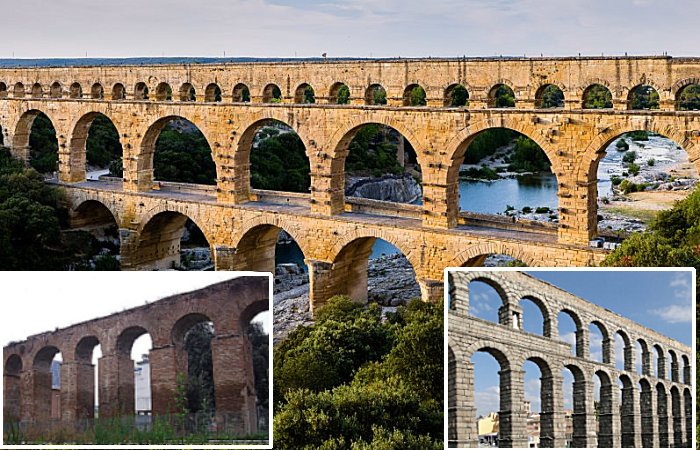A. Sutherland - AncientPages.com - Among all the achievements of ancient engineering, Roman aqueducts belong to the most exceptional ones.
The multiple arches of the Pont du Gard in Roman Gaul (modern-day southern France). Source
Engineers in the ancient Roman Empire knew that these structures represented one of the most fundamental requirements for any town or city to exist.
The aqueducts of ancient Rome, with their enduring presence, left their mark on the landscape that goes beyond their practical function of supplying water to the Roman Empire's capital and remote urban centers of the vast empire.
These engineering marvels, standing as a tangible and awe-inspiring testament to humanity's ingenuity in harnessing and dominating the forces of nature, are not just relics of the past, but living monuments to our capabilities. They represent symbols of Rome's advanced civilization and a powerful reminder of the remarkable achievements that can be accomplished through human innovation and determination.
In 312 BC, a Roman politician, Appius Claudius Caecus, ordered that an aqueduct be built to supply Rome with water.
Glimpse of the Park of the Aqueducts in Rome , where there is a strong concentration of Roman aqueducts. Image credit: - Flickr - CC BY 2.0
The aqueduct was one of two major Roman projects carried out during this period; the other was a road for military purposes.
The city must have water to drink, cook, and clean, but it also must have all the necessary arrangements to remove unwanted water. Both ancient and modern Rome have been well supplied with the means for delivering and taking water away.
Ancient Romans were highly skilled engineers. By the early fourth century AD, Rome was being supplied by more than twelve aqueducts, which cooperatively could bring more than a million cubic meters of fresh water to the city daily!
This massive amount of water was delivered to Rome's inhabitants through a complex network of tanks and pipes and to about 1,500 public fountains, pools, and almost 900 public and private baths.
"With so many indispensable structures for so many aqueducts," remarked Frontinus, "compare, if you will, the idle pyramids or the useless, though famous, works of the Greeks…." wrote Sextus Julius Frontinus around AD 98 in his book 'De Aquis Urbis Romae' (About the Waters of the City of Rome).
The Aqueduct of Segovia is a Roman aqueduct in Segovia, Spain.The aqueduct was built of unmortared, brick-like granite blocks. source
This book provides much of our knowledge of the Roman water supply system. Frontinus was a prominent Roman civil engineer and the top official overseeing Rome's water supply. In his book, he describes Rome's aqueducts.
Usually, we think of the Roman aqueducts as a series of tall, impressive stone arches visible above the ground. Later, aqueducts included some (less than 10 percent) sections carried on massive arches. However, the first aqueduct, the Aqua Appia after its builder, was underground. It took its water from some springs about 25 kilometers outside the city. It had a capacity of approximately 75,000 cubic meters of water per day, delivered to the area around Aventine Hill.
Frontinus tells us about the Aqua Appia:
'For four hundred and forty-one years from the foundation of the City, the Romans were satisfied with the use of such waters as they drew from the Tiber, from wells, from springs...'
The following Roman aqueduct (mostly an underground channel), Anio Vetus, was the second oldest after the Aqua Appia. It was built in 272 BC and funded by treasures seized after the victory against Pyrrhus of Epirus (318-272 BC).
Considered an engineering masterpiece, the Anio Vetus was unique due to the complexity of its construction. It was four times as long as the Aqua Appia, its source much higher, its flow was more than twice, and it supplied water to higher elevations of the city.
It had a capacity of around 180,000 cubic meters per day and, as its name suggests, drew its water from the Anio River valley (the source of its waters – dates back to 272 BC), located east of Rome.
The experiment with Aqua Appia was very successful and became an essential part of life in Rome. By the third century AD, the city had eleven aqueducts that provided over one million people with water. The eleven aqueducts had a total distance of approximately 800 kilometers, of which fewer than 50 km ran above ground on masonry support.
Ruins of the Aqua Anio Vetus, a Roman aqueduct built in 272 BC. Image credit: - CC BY-SA 3.0
Using a lot of water had become part of the lifestyle of Rome's inhabitants. Here, for example, there were lots of public bathhouses.
The eleven aqueducts provided Rome with about one million cubic meters of water daily.
The aqueducts made it possible to live much better and more accessible. There was enough water for daily life, fountains, toilets, public baths, and flower gardens. Aqueducts also brought water to mines, mills, and agriculture.
Baths also became social gatherings for the Romans. At more significant buildings, there were even gardens and libraries, and water surrounded people, constantly pouring from the aqueducts.
The Romans were excellent engineers who were skilled at constructing aqueducts; they built much more prolonged and extensive structures than their predecessors. However, the aqueduct itself was not a Roman invention; the Roman engineers knew the principle of the aqueducts used by Greeks and Etruscans.
When the Roman Empire expanded, the construction of aqueducts spread to other parts of Europe, North Africa, and Western Asia.
As the Roman Empire extended its range to other areas, "aqueducts appeared everywhere where the Romans appeared" (A. T. Hodge, Roman Aqueducts & Water Supply).
Written by – A. Sutherland - AncientPages.com Senior Staff Writer
Copyright © AncientPages.com All rights reserved. This material may not be published, broadcast, rewritten or redistributed in whole or part without the express written permission of AncientPages.com
Expand for referencesReferences:
Hodge A. T. Roman Aqueducts and Water Supply
Coarelli F. Rome and Environs: An Archaeological Guide
